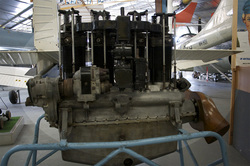CIRRUS aircraft engines
 Click on image for larger version
Click on image for larger version
The Cirrus and Cirrus-Hermes were a series of aircraft engines manufactured in Britain from the 1920s to the late 1950s. All were four cylinder, air cooled and inline beginning with upright mounting and later inverted.
In 1924, Geoffrey de Havilland was looking for a reliable engine with suitable power to weight ratio and cost parameters for his new de Havilland Moth design.
The Aircraft Disposal Company (ADC) were marketing a development of the WW1 Renault V8 aircraft engine and de Havilland proposed that half of one of these engines would make a four cylinder inline engine with the parameters he sought, and with the re-design it became the Cirrus 1, 60hp four cylinder air cooled inline aircraft engine, the first of such that would go into quantity production. The engine was launched in the de Havilland Cirrus Moth in 1925.
From 1926 to 1929 the ADC produced three variants of the Cirrus engine with power increasing to 105hp.
Cirrus Aero Engines was formed in 1928 to manufacture Cirrus engines as the ADC were running out of Renault engines. The company was subsequently taken over by the Independent Cirrus-Hermes Engineering Company that was formed in 1931. Four variants of the Cirrus-Hermes engine were produced with power ranging from 105 to 140hp.
With a change of ownership to Blackburn and General Aircraft Limited in 1934 the Cirrus range continued to be produced until the late 1950s.
TECHNICAL DATA
Specifics of the Cirrus 1 engine
Type : Upright four cylinder air cooled piston engine.
Bore : 4.13in (105mm) Stroke : 5.12in (130mm)
Displacement : 274.36cu in (4.5L)
Dry weight : 268lbs (122kg)
Valve system : 1 inlet and 1 exhaust valve per cylinder.
Fuel system : Claudel carburetor
Power output : 60hp
Compression ratio : 4.7/1
In 1924, Geoffrey de Havilland was looking for a reliable engine with suitable power to weight ratio and cost parameters for his new de Havilland Moth design.
The Aircraft Disposal Company (ADC) were marketing a development of the WW1 Renault V8 aircraft engine and de Havilland proposed that half of one of these engines would make a four cylinder inline engine with the parameters he sought, and with the re-design it became the Cirrus 1, 60hp four cylinder air cooled inline aircraft engine, the first of such that would go into quantity production. The engine was launched in the de Havilland Cirrus Moth in 1925.
From 1926 to 1929 the ADC produced three variants of the Cirrus engine with power increasing to 105hp.
Cirrus Aero Engines was formed in 1928 to manufacture Cirrus engines as the ADC were running out of Renault engines. The company was subsequently taken over by the Independent Cirrus-Hermes Engineering Company that was formed in 1931. Four variants of the Cirrus-Hermes engine were produced with power ranging from 105 to 140hp.
With a change of ownership to Blackburn and General Aircraft Limited in 1934 the Cirrus range continued to be produced until the late 1950s.
TECHNICAL DATA
Specifics of the Cirrus 1 engine
Type : Upright four cylinder air cooled piston engine.
Bore : 4.13in (105mm) Stroke : 5.12in (130mm)
Displacement : 274.36cu in (4.5L)
Dry weight : 268lbs (122kg)
Valve system : 1 inlet and 1 exhaust valve per cylinder.
Fuel system : Claudel carburetor
Power output : 60hp
Compression ratio : 4.7/1
